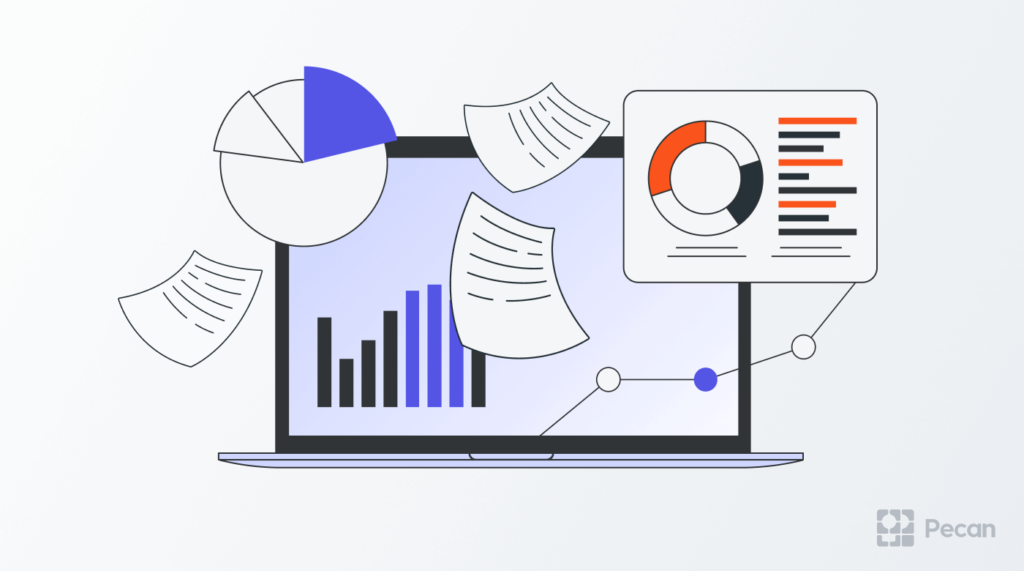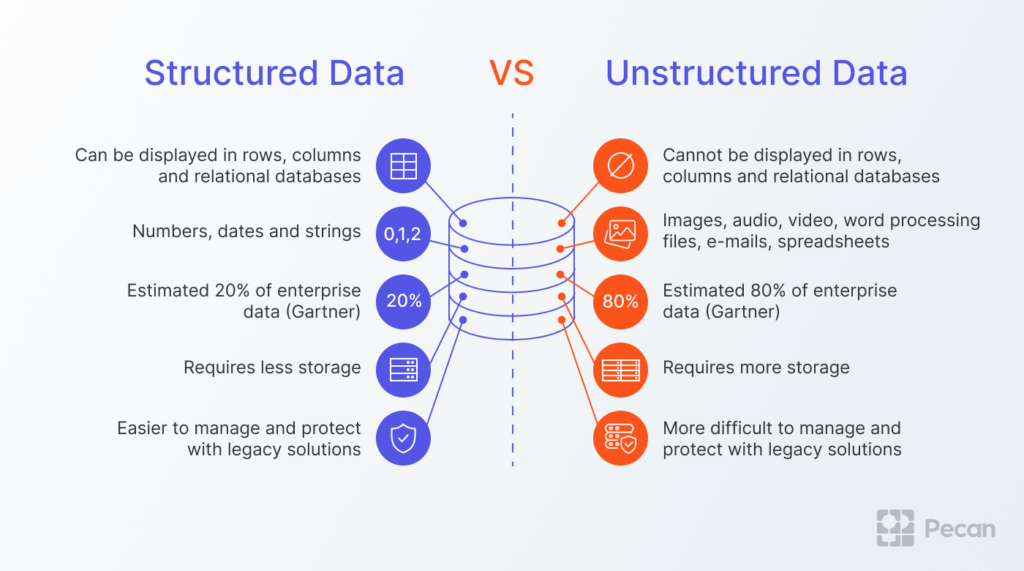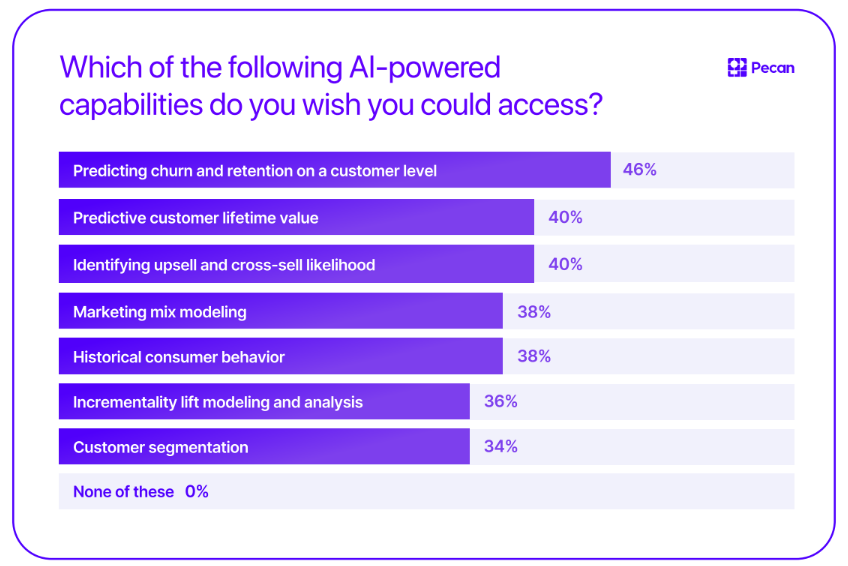As businesses try to make data-driven decisions, it can be overwhelming to make sense of thousands of different customer data points.
However, data is a necessary component to drive results that impact your KPIs.
More importantly, data is a key part of keeping you two steps ahead of your current and potential customers.
Savvy data-driven businesses know the difference between structured and unstructured data and how they affect your system, business intelligence, analytical processes, and overall growth.
In this article, we’ll review each data type, the key differences, and how you can leverage all kinds of data to take the best actions for your business.
Before we dive in, let’s define structured data and explore how most businesses use it.
What is structured data?
Structured data is a set of defining characteristics that are organized in a logical structure. The data tends to be very specific and often quantitative.
Since the data can be categorized, structured data is often easy to organize because it follows a set pattern that makes sense.
This also means structured data is easy to search for and analyze in any database.
Most data tools can process and analyze structured data because it’s familiar, standard, scannable, and easily digested.
Structured data takes advantage of standardized formats that provide a predefined structure.
Analytical tools and business applications can easily analyze common data types due to their identifiable structure, making it easy to extract rich business information from thousands or millions of data points.
Some key examples of structured data include numerical values, like dates, product SKUs, and phone numbers.
What is unstructured data?
Unstructured data represents multiple types of data that aren’t easily analyzed or categorized.
Usually, unstructured data is stored in its native format. These formats often include their original rich media composition.
Think of all the qualitative data your business has collected over the years. This data might be messy and tough to navigate. It can be difficult to put it into “buckets” or categories that are easy to analyze and evaluate.
However, unstructured data is more subjective when analyzed.
Some common examples of unstructured data include Word documents, text, rich media, audio, video, social media posts, and more.
Now that you know about structured and unstructured data, let’s compare the two and understand the value both can provide.
Structured data vs. unstructured data: What are the key differences?
There is a lot to consider when it comes to structured data and unstructured data. Is one type of data more valuable than the other? How should you store and analyze structured vs. unstructured data? Which data should you be looking at for a specific question you’re asking?
The pros of structured data
Structured data offers many pros for businesses. Some of the top benefits include:
- Filterable: Structured data is easy to find, filter, and retrieve due to how it is stored and categorized. Because it is quantifiable, it can fit into distinct buckets.
- Standardized: Structured data is uniform and easily understood across different systems. Different components of your tech stack will likely have similar structured data categories that can easily be analyzed or compared.
- Statistical: Structured data is commonly used for statistical analysis and works well with machine learning algorithms.
Although there are many pros of structured data, there also are a few cons associated with this data type.
The cons of structured data
Structured data has limitations. Some of the cons of structured data include:
- Inflexibility: Structured data must fit into predefined categories. This makes the data inflexible, and it must conform.
- Time-consuming: Getting structured data into a usable form can be a time-consuming task.
- Specialized knowledge required: Managing structured databases requires technical knowledge or enhanced skills.
With an understanding of the benefits and restrictions of structured data, let’s take a look at how unstructured data compares.
The pros of unstructured data
In addition to structured data (or even by itself), unstructured data can be valuable. Some of the pros of unstructured data include:
- Variety: Unstructured data is complex, versatile, diverse, and comes in many forms. This type of data can be more contextual than unstructured data.
- Vast: Most data in the world is unstructured, so this type can cover various topics and insights that would be valuable for companies.
- Nuanced: Unstructured data is often qualitative, which can reflect complete user or customer sentiments, feelings, or behaviors.
Collectively, unstructured data can provide more of an inside look into the minds of customers compared to structured data.
The cons of unstructured data
However, there are drawbacks to unstructured data. Some of the cons of unstructured data include:
- Complexity: Unstructured data is often not ready for quick retrieval since it can’t be easily organized or grouped into specific categories.
- Tough to analyze: Unstructured data can't be analyzed by general statistical models; this type of data typically requires AI and machine learning algorithms to extract meaningful, actionable business insights. This data type is more difficult to standardize and organize uniformly since it comes in multiple formats.
- Large size: Unstructured data is rich and heavy and can, at times, take up too much storage space on a device.
Is there any gray area, though? What about data that somewhat overlaps between the two types?
That’s where semi-structured data comes into play.
What about semi-structured data?
Semi-structured data is information that does not reside in a relational database but has some organizational properties that make it easier to analyze.
With some processes, you can store semi-structured data in the relational database.
Semi-structured data exists to ease space. An example of this data type would be extensible markup language (XML) data.
This type of data is unstructured data stored in a relational database, making it easier to synthesize and understand. Popular formats include JSON, CSV, and XML.
In semi-structured data, metadata is a defining feature, using tags and semantic markers to make this data easier to access and search.
This type of data can be valuable for businesses that are looking to supercharge their unstructured data and make sense of it in an easy-to-digest way.
Analyzing any type of data, though, can be a daunting task.
That’s why businesses use AI, machine learning, and predictive analysis to enhance their data and modeling to make smarter business decisions.
How to use structured and unstructured data in predictive analytics for business success
Machine learning can play a role in evaluating structured and unstructured data.
Sometimes, structured and unstructured data is imported into machine learning models to perform predictive analysis for forecasting and other needs.
Structured and unstructured data in machine learning
With machine learning, you can extract meaning from complex data types by converting unstructured data into semi-structured or structured data.
In other words, machine learning and AI can take unstructured data and make it actionable for businesses.
Systems can leverage machine learning and AI capabilities to take their data to the next level.
Without AI or machine learning, your data is a snapshot of your current state. You could manually create projections based on your existing data, but those might be prone to human error or subjectivity.
With machine learning and AI, you can model future projects based on defined inputs to understand more about your potential future costs, revenue, or other variables.
Now that you know how structured and unstructured data can be leveraged, let’s define predictive analytics and how businesses use it to drive incremental revenue.
What is predictive analytics?
Predictive analytics is a type of modeling that often uses machine learning or AI to make informed, data-driven forecasts about the future.
Businesses use predictive analytics fueled by machine learning/AI to reach the next level.
Marketers are seeking to use predictive analytics to understand different aspects of their business.
More than 46% of marketers want to predict churn and retention on a customer level, while 40% of marketers want to predict customer lifetime value.
(Image Source)
As for why they use predictive analytics, their reasons may differ.
You might consider using predictive analytics to understand how much to invest in a marketing campaign or how much revenue you might drive in Q4.
Think of predictive analytics as an additional tool in your toolbox to use when mitigating risk about a future decision.
You can certainly decide without it, but with it, you’ll be more equipped to drive your business in the right direction.
This analysis helps businesses make informed, valuable predictions on what their leads/customers may do next.
Taking action with predictive analytics
One popular use case for predictive analytics is predictive lead scoring.
Predictive lead scoring enables marketers to understand more effectively which leads to concentrate on and which to ignore. AI algorithms analyze and flag the leads to focus on.
The more promising leads will be prioritized for sales team members to contact or to potentially upsell and cross-sell.
This technique will ultimately save your business money by enabling you to allocate your resources effectively and let your marketing/sales team concentrate on the areas that drive revenue growth.
Without predictive lead scoring, you might be calling or marketing to leads without interest in buying.
This is just one of many use cases for predictive analytics.
Businesses that adopt predictive analytics and synthesize their structured and unstructured data will be the ones that soar past their competition and increase their bottom line.
Making sense of your data
Structured data is easily categorizable data that makes it easy to derive meaning from its analysis, at least without manual effort.
Alternatively, unstructured data is more complex and requires more contextual and sometimes even cultural understanding to process.
Often, structured data is easily analyzed with any data analytics system. But making the most of that structured data requires using an AI platform that can give you a look into the future, feeding your data into machine learning algorithms that generate accurate predictions.
Try Pecan AI today to create impactful, actionable decisions based on all your data to get ahead of the game.






